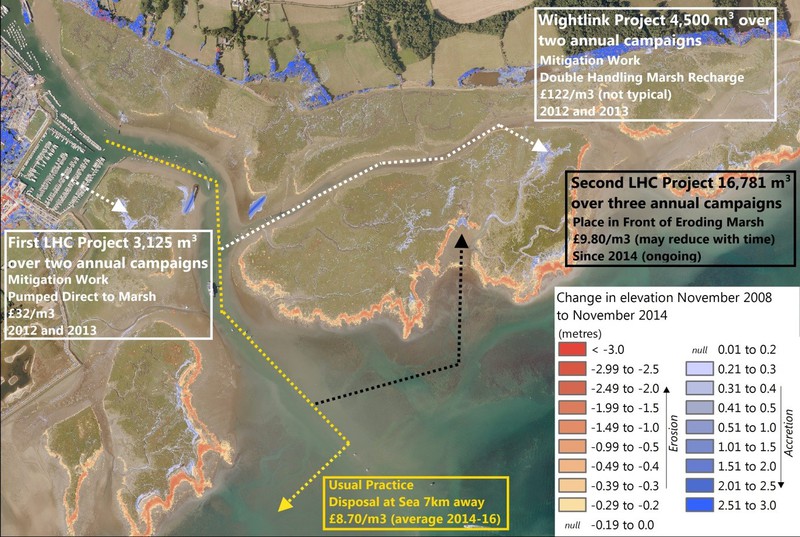Habitat and wetland restoration
Between 2012 and 2016, several beneficial use projects were carried out to protect/restore eroding marshes at the mouth of Lymington Estuary (UK). The exposed seaward edges of these marshes have been retreating since the middle of the 20th Century and they are also deteriorationg internally due to ‘die-back’[1]. These marshes play an important role in shielding Lymington’s marinas, moorings and sea defences from wave attack. Approximately 30,000 m3 of maintenance dredgings are taken from the harbour’s marinas and the navigation channel each winter. In the past, all this sediment was taken out of the estuary to a disposal site. In recent years though, a proportion has been placed on top of, or near to, the marshes to help slow their decline. This work has been led by Lymington Harbour Commission (LHC) and Wightlink Ltd with three different projects having been undertaken:
- 1st LHC Campaign (2012 and 2013): 3,125 m3 of sediment were pumped directly from a marina to an adjacent marsh using a cutter suction dredger. This was carried out to offset impacts on intertidal habitats from the construction of rock-armour breakwaters protecting the harbour entrance;
- Wightlink Ltd Campaign (2012 and 2013): 4,500 m3 of sediment were back-hoed into barge for transfer to the site and then ‘cutter suctioned’ to a decaying marsh. This was done to offset any impacts to intertidal habitat from the operation of a ferry service; and
- 2nd LHC Campaign (2014 to 2016): 16,781 m3 of sediment was back-hoed into a barge and ‘bottom deposited’ to a lower intertidal area fronting the eroding marshes. The new licence issued in 2017 now authorises placement of up to 10,000 tonnes per year until 2024.
Monitoring of these projects has provided useful lessons about the technical aspects (e.g. sediment delivery and retention) and ecological value (e.g. plant growth) of such work. It has been valuable that different techniques were employed at one location as this allows direct comparisons to be made between approaches. In particular, it helps to understand the comparative costs which will help inform future projects (the fee details have been kindly shared by LHC and Wightlink Ltd.). The LHC has also, helpfully, further analysed the fees for different elements of the projects (consenting, monitoring and implementation) and compared them against the disposal at sea alternative.
[1] The exact cause of this has not been confirmed, but it is likely to be either exacerbated by, or driven by, sea level rise and increased tidal inundation as well as an insufficient sediment supply reducing the marshes’ ability to cope with these factors.
Graphical information:


References/web links
- ABPmer. (2015) Lymington to Yarmouth Ferries: Mitigation and Monitoring 9th Report for the Environment Management Panel Report for Wightlink Ltd R.2512 December 2015
- http://www.omreg.net/query-database/142-boiler-marsh-lymington/
- ABPmer, (2017). White Paper: Using Dredge Sediment for Habitat Creation and Restoration: A Cost Benefit Review ABPmer Internal White Paper, Report No. R.2865.
- Black and Veatch (2017) Lymington Harbour Commissioners Saltmarsh Recharge By Bottom Dumping – Phase 3 Final Monitoring Report
- Lowe, S., (2012). ‘Lymington Harbour habitat replenishment scheme: Summary of works’.The Crown Estate, 18 pages. ISBN: 978-1-906410-35-3
- http://www.omreg.net/query-database/141-lymington-yacht-haven-marina/